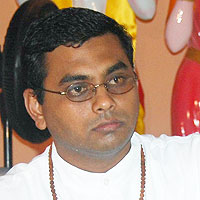From a satsang with Pt. Umadutt Maharaj, Spiritual Leader, SWAHA Bhakti Jyoti Mandali
The nine days of Nav Raatri are among the most significant on the Hindu calendar. At this time, devotees intensify our religious practices and sacrifices, giving thanks to the manifestations of the Divine Mother for life and success. During Nav Raatri, the performance of puja, whether a personal havan or a ceremony officiated by the pundit, helps to purify and bring blessings to our homes. It is also an important time to worship Devi Maa so as to increase our own positive vibrations and energies, which serve as a shield against all negativities in life.
During Nav Raatri, and throughout our lives, the more religious practices we perform and the more efforts we make spiritually, the more positivity we invite into our lives. We must remember that every religious practice we perform is for our own benefit. Our physical form is a miniature universe. Thus, when we worship Devi, we are really developing divine qualities within ourselves. When we worship Durga Devi, we are worshipping the divine power within us in the form of energy. Each of the nine forms of Devi that we worship during Nav Raatri represents a power or energy within us.
Durga Maa represents each of the nine Devis. She is depicted with a tiger as her vehicle, which is deeply symbolic. She subdues the tiger and it travels according to her will. The tiger represents the animalistic qualities in humans. We must subdue those negative qualities in order to advance along the spiritual path. We might not be able to eliminate them entirely, but we can transcend them. The sadhanas, religious practices, that we perform help us to transcend the demonic qualities that exists in us all. It is also important that we take the time to understand the reasons for our religious practices and the meanings of our bhajans. This is a form of gyaan ka suraj, whereby we understand the deep significance behind each of these religious acts. This is the highest form of devotion, gyaan bhakti or ‘enlightened worship’.
When we worship the nine kanyas (young girls) on the last night of Nav Raatri, we worship them with love and consideration as if we are worshipping the representations of Devi. The kanyas usually range from two to ten years old; the youngest girl is called Kumari, followed by Trimurti, Kalyani, Rohini, Kalika, Chandika, Shambhavi, Durga and Subhadra. These forms of Devi represent the powers and functions of the Devi for spiritual advancement in our lives.
- The worship of Kumari leads to the extinction of all miseries and poverty.
- Worshipping Trimurti blesses us with longevity, the acquisition of power and the six forms of spiritual wealth: serenity, tranquility of mind, control of senses, endurance, faith and renunciation of all selfish acts.
- Worship of Kalyaani leads to victory over all negativities, happiness and the realization of all noble desires.
- Rohini is the curer of all diseases, and the destroyer of all internal enemies: anger, greed, lust, hatred, jealousy and ego.
- Worship of Kaalika Devi leads to prosperity.
- Chandika Devi blesses us with strong devotion to the Divine Mother.
- Shambhavi Devi frees us from poverty, misery and victory over all negativities.
- Durga Maa represents the inaccessible. She destroys awful and terrible enemies and bestows happiness in this world and the world beyond.
- Subhadra fulfills all our right desires.
If we worship these kumaris with great devotion, all negativities are eliminated from our lives and we are blessed with auspiciousness. Let us prepare ourselves spiritually during the period of Nav Raatri to worship the Divine Mother so that our lives, our families and our country will receive Her divine blessings.



